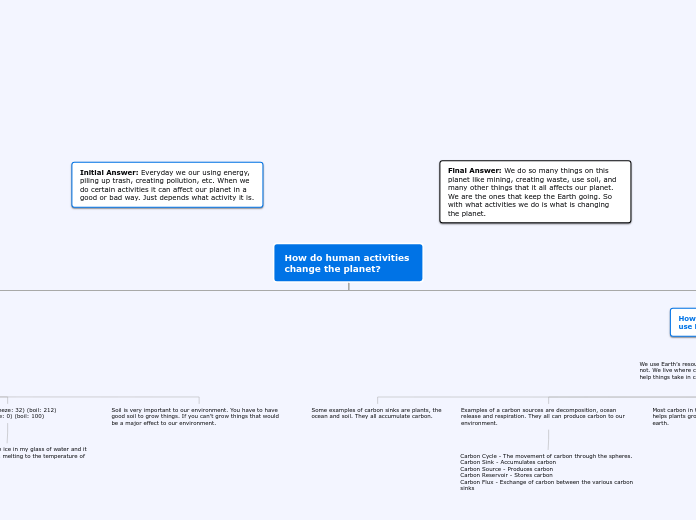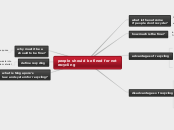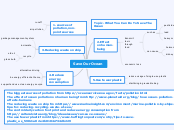Initial Answer: Everyday we our using energy, piling up trash, creating pollution, etc. When we do certain activities it can affect our planet in a good or bad way. Just depends what activity it is.
Final Answer: We do so many things on this planet like mining, creating waste, use soil, and many other things that it all affects our planet. We are the ones that keep the Earth going. So with what activities we do is what is changing the planet.
How do human activities
change the planet?
It actually causes a lot of issues. We create so much waste there isn’t enough room to put it all before it can degrade. We are running out of landfills it is going into our oceans affecting the marine life, which they are dying.
Steps of recycling:
1. collecting the recyclables
2. processing the recyclables and turning them into recycled-content products
3. purchasing recycled products
One way you can help creating waste materials is buy dish towels instead of paper towels. Buy rechargeable batteries instead of regular batteries. Use canvas bags at the grocery store instead of getting plastic grocery bags. Stop using plastic straws!!
I reuse dish towels, we don’t use paper towels often. Also, we have a recycling bin at out house. We really eliminated plastic straws to help get rid of them. We also added egg shells and banana peels to the compost pile instead of throwing them away.
We don’t have enough room in our landfills to keep putting waste in them. Landfills and incinerators can pollute the environment and are expensive to operate.
One problem with landfills is leachate. That is a liquid that forms when water seeps down through a landfill and collects dissolved chemicals from decomposing garbage.
-Biodegradable: Can be broken down by biological processes
-Compost: Rich in nutrients that helps plants grow
-Recycling: The process of reusing materials or recovering valuable materials from waste or scrap
Solid waste- Any discarded solid material.
Biodegradable- Can be broken down by biological processes.
Municipal solid waste- waste produced by households and businesses.
Source reduction- Any change in design, manufacture, purchase, or use of materials or products to reduce their amount or toxicity before they become MSW.
Compost- Rich in nutrients that helps plants grow.
The U.S. generates over 10 billion
tons of solid waste every year.
Developing energy helps Earth’s living systems because it makes it easier for us to do things. It can affect the earth’s nonliving systems because it can create pollution and other things like that which is not good for our environment.
The relationship between a growing population and the resources available has developed human societies. As a society we are growing in human population which means more activity and with that we impact the environment by using more energy.
Nonrenewable energy sources are like
fossil fuels, which can not be reused.
I use energy by using non-renewable batteries, leaving
lights on, heating and cooling our homes etc. I can do
better in the future.
Renewable energy is energy from a source that is replenished quickly enough that it will not be used up faster than it can be produced. Some sources are solar, wind, water, heat from earth.
Surface mining pros are it is cheaper, can recover more of the resource, and is safer. Cons of it are it includes environmental impacts, such as erosion and contamination
Fossil fuels- Remains of organisms that changed into coal, oil, or natural gas.
Electric generator- a machine that converts mechanical energy or motion, into electrical energy.
Natural Hazards- Effects of specific Earth processes that can cause harm to people and property.
Subsurface mining pros are it is safer than surface mining, less disruptive to the environment, leads to more minerals. Some cons to it is it costs more, harder to do than surface mining, takes a lot of time.
How do human societies
use Earth’s resources?
We use Earth’s resources all the time whether you realize it or not. We live where carbon is and for that we do things that help things take in carbon.
Almost all living things on Earth are
carbon-based. CO2 dissolves in water.
An increase in atmospheric CO2 keeps solar radiation from going back into space. This then increases global temperatures. With greenhouse gasses plants can grow and ice caps will start to melt.
More carbon is moving to the atmosphere as humans get rid of forests by burning the trees. On the farm we burnt down part of a tree while burning other materials in the timber.
Most carbon in the atmosphere is in the form of CO2. CO2 helps plants grow. Geosphere contains 99.9% of the carbon on earth.
Examples of a carbon sources are decomposition, ocean release and respiration. They all can produce carbon to our environment.
Carbon Cycle - The movement of carbon through the spheres.
Carbon Sink - Accumulates carbon
Carbon Source - Produces carbon
Carbon Reservoir - Stores carbon
Carbon Flux - Exchange of carbon between the various carbon sinks
Some examples of carbon sinks are plants, the
ocean and soil. They all accumulate carbon.
What issues does waste
from humans cause?
This can cause environmental problems with all the waste we create. It can cause pollution, clutter, and get into our oceans affecting the marine life.
Soil is very important to our environment. You have to have good soil to grow things. If you can’t grow things that would be a major effect to our environment.
Fahrenheit- (freeze: 32) (boil: 212)
celsius - (freeze: 0) (boil: 100)
My connection is when I have ice in my glass of water and it melts. It is because the ice is melting to the temperature of the water.
-Exposed rock breaks down faster than covered rock.
-Water, wind, and gravity combine to move sediment from high to low elevations.
-The more the sediment is moved the smaller it becomes.
Weathering- breakdown of rock into smaller pieces.
Erosion- Removal and transport of material.
Deposition- dropping of material such as sediment.
Surface Processes - Affects the geosphere at or near Earth’s surface and driven by mostly external energy
Soil - A loose mixture of rock fragments and organic material that can support the growth of vegetation
Melting point - The temperature at which a solid becomes a liquid
Boiling point - temperature in which a liquid has acquired enough energy to transform into a gas
A gas to a liquid is condensation, liquid to solid is freezing, solid to gas is sublimation. It can go the opposite way also. Gas to solid is deposition, solid to liquid is melting, liquid to gas is evaporation.
What is the impact of developing
and using energy resources on
Earth’s living and non-living systems?
It affects us because as time goes on things change and develop into more complex things. That can help with the living and non-living systems.
To make a cake you need all the ingredients to start making it. Then the goldilocks conditions will be the steps to make the cake. Get all of the things you need, preheat oven, mix ingredients, put into a pan, bake cake, set time, take out and let cool.
Goldilocks went to the three bears house and tried all of their porridge. Papa bear’s was too hot. Mama bear’s was to cold and baby bear’s was just right. Therefore she went in steps to get to the end for a result.
As you build a house it goes in steps and you have to start with a foundation and then build up from there. It progresses as time goes on.
Life lives on land so they have an impact to the both of them. For life to occur we need land to live on. Over the years it has turned into more complex forms.
negative: less wolves, no human interference,
no population change, less wolves.
positive: less wolves, human
interference, the population increase.
Microbial life on land
increased formation of soil.
Goldilocks conditions: the steps of something in order
Life: the existence of an individual human being or animal
Land: the part of the earth's surface that is not covered by water, as opposed to the sea or the air
-Threshold #1 - Photosynthesis - 3.5 BYA
-Prokaryotes evolved deep in the ocean near massive vents
-Threshold #2 - Eukaryotes - 2.5 BYA
-DNA in a nucleus
-Threshold #3 - Multi-celled Organisms - 1 BYA
-Different Eukaryotes came together to form more complex life-forms-billions of cells
-Threshold #4 - Development of Brains - 500 MYA
-Multi-celled organisms had nerve cells
-Threshold #5 - Life Moves to Land - 475 MYA
-Plants and fungi left ocean
-Threshold #6 - Mammals - 250 MYA
-Amphibians needed to go to water for reproduction
How has human society
been influenced by the
availability of rock, mineral,
and energy resources?
We use all of those resources to do many different things to our planet. We use them as resources for building things and survival equipment. They all play a big role today in our society.
Positive Feedback: Work hard → Get good grades → More privileges
Negative Feedback: body temperature rises, body sweats more, body temperature drops, body temperature now rises again
I can connect to the positive feedback. I go to volleyball practice, get better each time, help win tournaments. It just keeps going up from there.
Those are the four spheres in our Earth. They all interact with each other somehow. Like the wind and air in the atmosphere helps circulate the oceans and waters, in the hydrosphere. All living things in the biosphere need water which they get from the hydrosphere.
Geosphere- the solid Earth and soil (landforms, the crust, and the interior of the Earth)
Atmosphere- the blanket of gas that surrounds the Earth that extends to the edge of space (air, precipitation, clouds, and atmospheric aerosols)
Biosphere- all living things (bacteria, plants, animals)
Hydrosphere- all bodies of water in all forms of water (oceans, rivers, lakes, glaciers, ice caps, clouds)
Feedback- One process changes the second process
Positive Feedback - Amplifies the change in the first process
Negative Feedback - stabilizes change in the first process









